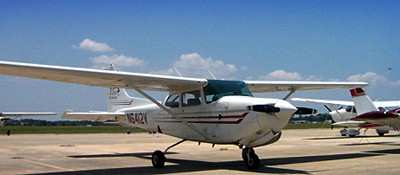Clarifies The 'Idle' Setting For Engine Operation
The FAA has issued a Special Airworthiness Information Bulletin
(SAIB) to inform owners and operators of an airworthiness concern
on 1996 and after Cessna Model 172R and 172S reciprocating engine
powered airplanes.
Cessna 172R File Photo

The FAA has been involved in issues with respect to proper
performance of the engine with the throttle control at idle. There
appears to be a lack of understanding of what “idle”
is. Engine operation at idle can be described as operation of the
engine with the cockpit throttle control pulled full aft (closed).
This is where the throttle control stops moving aft, taking into
account any cushion or hysteresis within the control installation,
after being released. It’s not a “hard” stop, nor
a “soft” stop. It is the engine performance that
results when the position of the fuel/air control units throttle
lever is resting on the throttle stop set screw on the fuel/air
control unit when the cockpit throttle control is pulled full aft
and released.
There also could be a lack of understanding of what smooth,
proper engine operation is with the throttle at idle. Engine fuel
flow settings that are not within allowable limits and that may not
be readily detected can prevent the engine from being capable of
proper operation with the throttle at idle when the pilot reduces
power for any reason, i.e.; approach to landing, power off stalls,
etc. A typical reason for the engine’s inability to operate
at the idle stop is an over-rich mixture, which may also lead to
the engine not restarting using published in-flight restart
procedures. Over time, the engine fuel servo has
been shown to have the potential to shift to an over rich condition
with the throttle at idle. This stems from the potential for the
engine fuel servo to shift to an over-rich condition or be set such
that an overrich condition exists with the throttle at idle. The
concern is that operators could be circumventing poor engine
performance at idle by slightly increasing the throttle setting
during ground operations before takeoff. This can result in poor
engine performance re-appearing as power is reduced to idle during
flight operations. This can result in unexpected and serious
operational consequences.
There has been FAA airworthiness directive (AD) activity and
Cessna and their suppliers have published numerous operational and
service documents to address, component changes, process changes,
etc. dealing with idle speed, idle mixture as well as fuel
injection system component performance and care. The end goal of
much of this documentation is proper performance of the engine at
idle.
There are three key factors to the proper performance of the
engine at idle:
- Idle RPM.
- Lean rise.
- Understanding engine roughness.
Cessna has also taken action to include information in their
service documents for these models to address these three factors
to further improve the operator and maintenance communities
understanding of what proper engine performance should be with the
throttle at idle. Cessna has also published updates to all of the
pilot’s operating handbook and FAA-approved airplane flight
manuals and maintenance manual to further clarify proper
performance of the engine with the throttle at idle and address
engine roughness.
The FAA recommends that owners and operators of the airplanes
identified above review, understand, and adhere to the limitations,
operating and maintenance information defined in the latest
pilot’s operating handbook & FAA approved airplane flight
manuals (POH/AFM) and maintenance manual for the applicable
airplane model. We also recommend adherence to the procedures in
the Model 172R/172S Maintenance Manual, at Revision 14 or later,
contained in Section 73-00-01,
pertaining to “Idle Speed and Mixture Adjustment”.
At this time, this airworthiness concern is not an unsafe
condition that would warrant AD action under Title 14 of the Code
of Federal Regulations (14 CFR) part 39.
 Classic Aero-TV: The Switchblade Flying Car FLIES!
Classic Aero-TV: The Switchblade Flying Car FLIES! ANN FAQ: Q&A 101
ANN FAQ: Q&A 101 ANN's Daily Aero-Term (04.12.24): Discrete Code
ANN's Daily Aero-Term (04.12.24): Discrete Code ANN's Daily Aero-Term (04.13.24): Beyond Visual Line Of Sight (BVLOS)
ANN's Daily Aero-Term (04.13.24): Beyond Visual Line Of Sight (BVLOS) ANN's Daily Aero-Linx (04.13.24)
ANN's Daily Aero-Linx (04.13.24)



